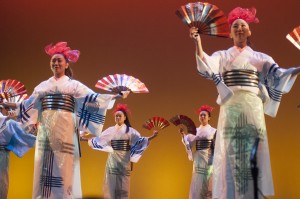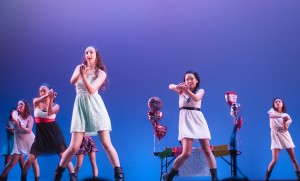Kristen Sadakane, a fourth-generation Japanese American, does not celebrate many Japanese traditions or speak Japanese with her family. She said she has been Americanized – and people have pointed it out to her since she was a child.
It started in the second grade when her classmate, a second-generation Japanese American, told her, “You’re not Japanese.”
The words marked the first of many timesSadakane, a fourth-year Design | Media Arts student, realized there was a difference between “yonsei” – fourth-generation Japanese Americans – and “shin-nisei” – second-generation Japanese Americans.
The Nikkei Student Union’s 28th annual Cultural Night called “Mending the Chains” addressed disparities in culture and identity experienced by different generations of Japanese Americans. The event, held Monday evening in Royce Hall, commemorated the incarceration of about 110,000 Japanese Americans in internment camps during World War II.

(Miriam Bribiesca/Daily Bruin)
The student-run production featured the performing arts groups Nikkei Student Union Odori, Nikkei Student Union Modern, Kyodo Taiko and V-TONE. The performances were tied together with a student-written drama, encompassing the themes of this year’s Cultural Night: unity and cooperation.
Hilo Naiki, a fourth-year economics student and co-producer of the event, helped write the script of a drama that unfolded in several scenes throughout the night.
Naiki said he wanted this year’s drama to focus on present issues faced by his age group of Japanese Americans, such as the hope for combined cooperation of the shin-nisei and yonsei generations.
Group members said they think the message resonates beyond the Japanese American community and UCLA.
“What we’re trying to address – the clear-cut difference between fourth and second generations – is not just specific to us. The problems we face aren’t just our problems,” Naiki said.
The drama was told through the character Dave, a shin-nisei teenager who was killed in a car accident. The first scene opens with a higher power telling him to help other teenagers who are still alive and searching for their identity to not make the same mistakes he did, and help them find who they truly are.

(Miriam Bribiesca/Daily Bruin)
Daiki Hara, a second-year biophysics student who plays Dave in the drama, said he drew on personal experiences to gain a deeper understanding of his character.
“Sometimes I feel (like) I do a lot of things as an obligation to what my parents have provided for me,” Hara said. “I feel like I basically need to do every opportunity UCLA offers me, and that means I overwork myself.”
Reid Taguchi, a fourth-year film student who worked on the script and directed the closing dance of the production, said the drama’s story was a universal one about finding one’s identity and choosing one’s passions.
Through the characters in the drama, Taguchi said he tried to connect different facets of what it means to be a Japanese American.
For much of the script, Taguchi found himself writing from his own experiences of being a fourth-generation Japanese American.
Taguchi said playing basketball when he was younger caused conflict between himself and his family. Basketball was something his family thought should be done during free time. His top priority had to be getting good grades, which he owed to his family.
In the drama, a yonsei character also plays basketball, and his situation mirrors Taguchi’s. Another character, a shin-nisei, loves Taiko drumming, but is discouraged by his parents and their wish for him to become a doctor.
The on-stage representation of Japanese culture was meant to drive home the Nikkei Student Union’s overarching theme of achieving unity in the community, Hara said.
“Within your own community you need to understand that there can still be cliques, that within each of our own respective races, we divide ourselves by something,” he said. “It’s important to look through the eyes of others and allow each other to understand and coexist.”
Sadakane, who participated in a dance performance, said the group’s two dances – a traditional dance as well as a more modernizeddance – served to represent the dichotomy within the Japanese American community.
The first dance, which reflected the shin-nisei generation, had slow movements accompanied by traditional shamisen music. Dancers were dressed in intricate robes and carried fans or wore masks. The second dance was set to a rock-and-roll adaptation of the same traditional music. But this dance, which represented the Americanized yonsei generation, was more fluid and had salsa-like hip movements.
The Nikkei Student Union spent $30,000 from multiple campus departments, donations, alumni and business outreach to produce “Mending the Chains,” said Nancy Matsukawa, a fourth-year psychology student and co-producer of Cultural Night.
Cultural Night closed with a dance where all actors and performers came together on stage. The dance, Taguchi said, was indicative of the unity and cooperation the Nikkei Student Union sought to convey to the audience.
Taguchi said he thinks pinpointing exactly what it means to be a Japanese American to any viewer is difficult, but at such a diverse campus like UCLA, it’s important to try.
“You’re constantly encountering so many different types of people, so many different backgrounds, so many walks of life, that if we have the ability to tell our story to people who are willing to listen, we absolutely should,” Taguchi said.
